 After walking three days from Biratnagar we reached Bhanjynag Kharkha. From the rebel activity on the pass it looked like the comrades, many of them women, were massing up for an operation. But there is still a month of the unilateral ceasefire to go and it turned out to be just a regular military exercise.
After walking three days from Biratnagar we reached Bhanjynag Kharkha. From the rebel activity on the pass it looked like the comrades, many of them women, were massing up for an operation. But there is still a month of the unilateral ceasefire to go and it turned out to be just a regular military exercise.
The Maoist training camp was intensive and strict. It ran from dawn to dusk and was led by a female trainer. Nima and Rima are sisters in their teens. With assault rifles slung over their shoulders and grenades on their belts, the two lined for morning drills.
Nima and Rima were 14 and 16 when their parents garlanded them and sent them off to join the Maoist militia two years ago. Since then the two have taken part in famous battles like Bhojpur and Siraha.
Comrade Chunauti and Sujata are also sisters. Their only brother joined the Royal Nepali Army and never returned home, so the girls also chose to take up arms. Chunauti is a section commander while younger sister Sujata is a political worker with the self-styled Kirat National Liberation Front.  The proportion of women in the Maoist ranks in eastern Nepal appears to be higher than in the west. "There is growing influence of female members of the Kirat community in the war," says Ashmita, district secretary of Khotang, "there is no discrimination against women in these areas which is why more women guerrillas."
The proportion of women in the Maoist ranks in eastern Nepal appears to be higher than in the west. "There is growing influence of female members of the Kirat community in the war," says Ashmita, district secretary of Khotang, "there is no discrimination against women in these areas which is why more women guerrillas."
In the Salleri, the Maoist 6th brigade is regarded as one of the Maoists' strongest units, more than half of the militants are women, most from Limbu, Tamang and Sherpa communities. "Women make very good assault commanders, they are more confident and tough," says political commissar Dipesh of the 16th battalion.
But no matter how tough they appear to be, most of the young women we talked to said they were homesick. That could be one reason why they are granted home leave. Nima was allowed to travel to Bhojpur from Sindhuli to meet her sister Rima, who works in a different battalion. "I miss my family, but the party has allowed us visits," says Nima who carries her firearm even while visiting home.
meet her sister Rima, who works in a different battalion. "I miss my family, but the party has allowed us visits," says Nima who carries her firearm even while visiting home.
How about sex and marriage? "Although Marxism does not prohibit anyone from falling in love, we believe in sex only after marriage," says Chunauti, who recently got married to a fellow-fighter from her company.
Maoist commanders have asked rank and file to be very cautious about relationships and not to marry outside the force. "It's best to find someone who shares similar ideals and thoughts. Your head has to lead your choice for love, sex and marriage," says Chunauti's unmarried sister Sujata, adding that she is still looking for a good match for her.
Despite the rules, personal problems have led some to abandon the movement. The district secretary of Khotang, Comrade Hiranya, recently deserted after being involved with district leader Comrade Bhumika. The chief of the district people's government from Okhaldhunga, Lanka Rai, also deserted the party and ran away with his subordinate, Comrade Resma.
"They were involved in an illicit relationship and have disgraced the party," says Comrade Asha, Janakpur coordinator of the Maoist-affiliated women's organisation.
Three years ago, the Maoists central women's department started surveying women guerrillas to analyse what kind of personal problems could come up. Female fighters answered questions about sexual discrimination by male peers and about difficulties related to pregnancy, contraceptives and other problems. But the survey was never finished. "Some of the forms reached the hands of the enemy, so it was discontinued," Comrade Asha told us.
The women fighters spoke in revolutionary jargon, but articulated clearly that they joined the movement to "liberate Nepali women". Many of women may not know the intricacies of the political debate in Kathmandu, but they appear concinced that by carrying a gun instead of a doko they will unshackle Nepali women. Says Asha: "The road to liberation is difficult, but we will reach it one day."
War correspondent
 Comrade Sunita, 18, is a reporter who often accompanies the militants with her tape recorder, camera, notebook and pen. Here she is (left) talking into her cordless phone in front of a chaitya that is emblazoned with Maoist grafiti.
Comrade Sunita, 18, is a reporter who often accompanies the militants with her tape recorder, camera, notebook and pen. Here she is (left) talking into her cordless phone in front of a chaitya that is emblazoned with Maoist grafiti.
A correspondent for the Maoist 'Radio Peopls's Republic' and Janadesh newspaper, she also has to participate in daily military training.
"We live and eat with the guerrillas and also report major battles. That's why this training is necessary for our own protection," explains Sunita. Like her, many other young women work for the rebels' information units. "The party has given special direction to involve more women in production and communication, in both the organisation and the frontline," says Comrade Srijana, Bhojpur district secretary.


